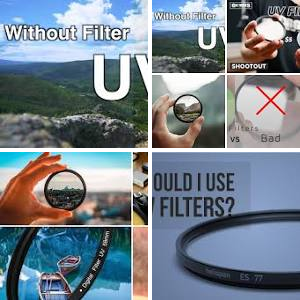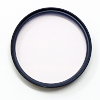Optical glass used in camera lenses has little to no UV transmission. Using a UV filter to cut out UV light mattered as little in the film days as it does now. This means that there's nothing a UV filter can do to improve image quality. If anyone doubts this, I actually finally have a working UV-VIS spectrophotometer at work now, and I'm happy to throw any lens I have that will physically fit in the beam path of it onto it and show the spectral transmission of a lens without a UV filter(as compared to the transmission of a UV filter).
Back in the film days, "Skylight" filters, which have a faint pink color, were popular and they can take a bit of blue tinge out of your photos. I'm not sure if anyone still makes Skylight filters(if anyone does, it's probably Tiffen) but there's also no shortage of them out there as long as you don't need them in a crazy size(and if you want known quality, since a lot of 70s and 80s filters were junk, Nikon's number is L1A, or L1BC for slightly stronger). I personally like something more along the lines of an 81A or even 81B sometimes for slide film, although that's not an all the time thing either(an L1BC is kind of an 81A "light" so is a great compromise for an all the time slide film lens).
The only practical benefit of a clear, uncolored glass filter has ever had has been to basically be a clear lens cap, or a front element protector.
The comment about "preventing" lens flare and ghosting is complete and utter nonsense. Flare and ghosting are a result of reflections inside a lens. Coatings have done a lot to improve this, but classic lens designs from the days before coatings, like the Triplet(often 3/3, sometimes 3/2), Tessar(4/3) and Sonnar(4/3), all were designed with an eye toward minimizing glass-to-air surfaces. In fact, lenses like the Planar(which is simple as modern lenses go, but as a 6/4 is complicated as older lenses go) didn't come into favor until practical coatings were around despite being a sharper/better resolving design than the Tessar.
Coatings are super advanced now, and 20 elements in a dozen groups are certainly not unheard of. I've quit even keeping track of how many a typical modern zoom has in it. I just looked out of curiosity, and the Nikon 24-70 f/2.8E I use all the time is a 20/16 design. That's for fast mid-range zoom without even a full 3x range.
In any case, throwing a filter on the front of your lens adds an additional glass to air surface, but unlike all the ones filling the body of your lens, its one the designers quite literally have no control over. Yes, the front of the front element is typically still coated, but there are also a lot of uncoated filters out there. In most situations, an uncoated filter will reduce contrast and create the potential for flare and ghosting. High quality coated filters may not have much practical effect, but the potential is still there.
When I bought the 24-70 f/2.8E I mentioned above, I was rather unhappy that it had an 82mm filter thread, as I did not have anything else with a filter thread that big(or at least not something else that doesn't also have a rear filter drawer). Good 82mm filters are expensive, and I did splurge a not small amount for a Nikon-brand polarizer to put on it. I think I lucked out and found a used, like new one at B&H for $175 or so, as I when I bought the lens I think they were around $250 new.
In any case, Amazon sells cheap "UV" filters, and I spent about $15 for an 82mm to stick on the lens. It was awful, and I found myself removing it most of the time-and a lens cap is a whole lot easier to remove than a filter!
These cheap filters have their place-they're great if you're in a dirty location and want something that you don't care about. When I took my X-T5 to the beach this past summer, if I hadn't had a polarizer on it, I'd have considered one of these filters just the ticket. If you want to play 80s wedding photographer and smear vaseline or clear nail polish or whatever else on a filter to make your own soft focus, vignette, etc, they're also a great canvas for that(but someone's old box of Cokin filters is even better for that with a lot of the hard work already done for you, and a lot of camera shops with boxes of those sitting around still might even pay you to get them out of their way).
Otherwise, though, if you insist on using them, first of all remember that a UV filter really is just a clear lens cap. With that in mind, though, if you're going to do it, use a good filter. It doesn't make any sense to me to use Canon L glass, Nikon gold ring/S glass, or whatever other premium glass your brand has(or even less than premium-even cheap lenses are pretty darn good these days) with a filter of questionable optical quality. I'm partial to Nikon filters, especially for polarizers, but they're not only optically excellent with great coatings, but I like the thin mounts. B+W is equally is good. Both of them make truly neutral polarizers and ND filters, something you can't necessarily count on from other brands. Hoya is probably 95% as good as either of those and often 2/3 or half the price for an equivalent filter(although Hoya makes a range of filter qualities-AFAIK Nikon only makes one quality of filter, and B+W has a pretty limited range). Tiffen is good for the oddball stuff no one else makes or that you'll only use occasionally. With all of these, even "UV" filters are expensive enough that you'll probably still want to use a cap and/or hood to protect the filter!
In the distant past, optical flatness was a real concern with cheap filters. Now I don't worry about that, but the name brand filters seem to all be coated these days and a lot of the generic ones aren't. That's a bigger deal to me. Also, this doesn't pertain to UV filters, but at one point maybe 10 years ago I bought a set of cheap yellow/red/orange 67mm filters on Ebay. I had just gotten by Bronica SQ-A and didn't have anything that fit it. I used the red(R60-and yes that's how it was labeled) and something was up with it-it acted a bit like a weak yellow filter with a little graying of the sky, but overall not much difference vs. no filter. R60 is sometimes called the "horror movie" filter since it should render(on panachromatic B&W film) the sky as nearly black but clouds as still bright white(yellow, Y48, is more practical for many uses as it it's a lot more subtle-light gray sky with white clouds, rather than just a featureless white sky with no filter). I gathered up all the R60s or whatever other naming convention I had in different sizes-even some ancient Kodaks in "series" sizes, some older store brand ones, and a few Hoyas, Tiffens, and other decent brands. Proper B&W contrast filters are "cut off" filter, meaning they have a sharp transmission cut-off below a certain wavelength. An R60 filter should only transmit 600nm and longer, and all the "good" ones I had worked this way, albeight with a bit less sharp of a cut-off on some of the cheap filters and one particular Kodak that had probably been used hard. BTW, this is why red filters have such a high filter factor. The Ebay cheapy just had a narrow cut-off band that made it look red to your eyes but didn't do much for the film.
Last thing too since several mentioned this-for lens protection, hoods on the whole are often the better choice. Not only do they give bump protection and keep fingers and such off your front element, but their optical impact ranges from "do nothing at all"(provided the hood doesn't cause vignetting) to "improves contrast." That's quite a different from UV filters, where "does nothing" is the best case scenario.
With all of that said, I do have a few 39mm Leica-brand UV filters on their way to me. I've just spent some money on Leica glass, and some of the lenses I have are notorious for the coatings and/or glass itself being notoriously soft and easy to damage when cleaning. I'll certainly use those with some discretion.
 Just one of the many, this from 2016:
Just one of the many, this from 2016:![1b2b7dd20b734f40c7696a68942c94d6.jpg]()
![bb73869d39b6ca6af350c0e570f3b9a2.jpg]()
![a85bdfe78c6c781511ff24dd66d50b47.jpg]()








